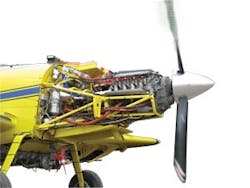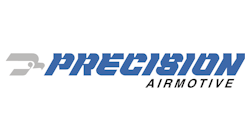Located in Midland, TX, Texas Reciprocating Air Craft Engines or TRACE feels the industry could benefit by having a reciprocating engine that can be used as an alternative to similar horsepower rated turbine engines, and it feels it has just the engine for this application.
Originally developed as the Orenda OE600A, in 2006, TRACE purchased the entire program which included the intellectual property, rights, and inventory of ORENDA, a Canadian manufacturer of type-certified and production-certified aviation engines.
In late 2009, TRACE was awarded a production certificate by the Federal Aviation Administration (FAA) for production of the type-certificated 600-hp engine — Type Certificate Data Sheet (TCDS) E00060EN. The TRACE engine is a liquid-cooled, high-performance reciprocating engine that the company feels is a viable fuel-efficient alternative to turbine aircraft engines with similar horsepower ratings, in certain aircraft applications.
So let’s take a little closer look at this technology. AMT spoke with TRACE chief operating officer, David Czarnecki and here’s what he had to tell us. “The engine in concept is similar to an automotive design, but the engine design was significantly strengthened in almost all components. It is important to note that this engine is not just an adaptation of automotive engine technology,” says Czarnecki.
The engine is a liquid-cooled turbo-charged eight-cylinder reciprocating engine in a 90-degree “V” configuration, specifically designed for aviation use. The construction of the engine uses primarily aluminum, steel, and magnesium materials. The engine block is aluminum with steel cylinder sleeves. The cylinder heads are also aluminum with steel insert parts, and have two valves per cylinder which are operated by pushrods off a single camshaft. Several of the engine covers are made of magnesium for weight conservation.
The engine has two gearboxes: one on the front of the engine to drive the propeller and the other on the rear of the engine designed to drive the accessories. The rear-mounted gearbox has mounting pad provisions for multiple accessories depending on the needs of the particular aircraft application. The engine has a dry sump lubrication system designed to provide 40 psi at idle speeds with a 120 maximum psi. The oil reservoir and plumbing are designed for the particular aircraft application for a minimum capacity of 16 quarts. The recommended lubricating oil is AeroShell 15W50 and the engine operates using 100 low-lead avgas. There are several approved three- and four-blade propeller applications between 85 and 106 inches in length.
Gearboxes, accessories, cooling, and engine speeds
Both the propeller drive gearbox and the accessory drive gearbox are designed with internal oil passages providing a high-degree of lubricant flow resulting in very durable gearboxes. The OE600A engine uses the Precision Airmotive RSA10 fuel injection system and two Bendix S-1200 magnetos for the ignition system with two spark plugs per cylinder. The turbocharger approved for use on the OE600A engine is the AlliedSignal Model TA94.
Czarnecki shares, “Aviation engines are typically designed to operate at power settings of approximately 75 to 100 percent of their maximum rpm. As a comparison, automotive engine designs typically operate at power settings of approximately 35 percent of maximum rpm. Operating at these power settings generates a lot of heat. The cooling system for the TRACE is designed to provide a coolant flow rate of approximately three times that of a similar automotive engine providing a high-degree of cooling efficiency and the flow through the engine is unique.” The maximum temperature for the engine coolant of 225 F and the maximum temperature for the engine oil is 210 F.
The engine currently has a time between overhaul (TBO) rating of 1,500 hours, but this TBO can be extended to 1,800 hours by working with the factory on an acceptable engine monitoring program including cylinder compression tests and a Spectrometric Oil Analysis Program (SOAP). Eventually, by use of field service, reliability, and maintenance data, TRACE hopes to have a program to extend the TBO to 2,000 hours.
The OE600A is designed to develop 600 takeoff horsepower at 4,400 rpm and 46 to 48 inches of manifold pressure (Hg) and a maximum continuous horsepower rating of 500 at 4,200 rpm and 39 to 41 inches of manifold pressure. The propeller drive gearbox has a reduction ratio of .4675 to 1. This means that at takeoff power with the engine running at 4,400 rpm, the gearbox output shaft for the propeller is turning at 2,057 rpm. The weight of the OE600A engine is approximately 730 pounds which includes engine-supplied/engine-mounted components, the fuel servo, the turbocharger, and related components.
Maintenance and training
Routine service and unscheduled maintenance can be easily accomplished in the field. For overhaul, TRACE recommends the engines be returned to the factory. So far only one engine has gone through the factory for repair/overhaul, along with two of the predecessor Orenda engines. This has provided the factory with valuable insight into the operation of the engine and the overall wear patterns so they can continually implement design improvements. At overhaul, the cylinders can be ground oversize by .010, .020, and .030, instead of replacing the steel sleeve inserts. TRACE provides a two-week training course for engine owners and service providers to teach the basic in-service maintenance program. So far four technicians have attended this training.
There isn’t a lot of operation history to provide yet for this engine. Currently there are OE600A engines on two Air Tractor AT401 agricultural aircraft being operated by Miccar Aerial of Yorkton, SK, Canada. Together they have approximately 1,300 hours of flying time.
AMT spoke with Allan Denesowych of Yorkton Aircraft Services the maintenance provider for these aircraft, regarding their experiences with the engines. Denesowych says, ”I feel the engine is very well built. The engine is still young and so far the maintenance has been simple, easy, and not much of it.”
Denesowych went on to say that routine maintenance tasks such as 50-hour oil changes and filter changes are easily accomplished with no access problems due to the remote location of the oil reservoir and filter. He commented there have been no maintenance issues with any of the cooling system components, and went on to say the engine analysis system in the aircraft provides the pilot with good information to assist with any troubleshooting.
Room for expansion
The TRACE facility is located on 22 acres with ample room for expansion. TRACE is planning for a capability of producing 120 engines per year and operating three engine test cells. TRACE is looking toward high-cycle utility aircraft as a potential market for this engine.
Czarnecki says, “This engine is not limited by the cycle time requirements that a typical turbine engine may be subject to, providing an advantage for operators of utility aircraft that have a high number of takeoff and landing cycles yet low hours of flight time.”
TRACE feels that new installations will be additional single engine aircraft having gross weights up to 6,000 pounds, and twin engine aircraft with gross weights up to 12,500 pounds.
In January 2010, TRACE successfully tested a production engine to more than 750 hp in its factory test cell. The engine had an experimental new-design camshaft.
According to Czarnecki, “The increased horsepower on our new engine will open doors to general aviation applications that are currently powered by 750-hp turbines.”
The TE750 will have electronic ignition and fuel injection systems. TRACE Engines plans to eventually offer its TE750 with enhancements to its current production certified OE600 model. The electronic engine management system will also be applied to the OE600 engine as a performance enhancement kit for engines in service, and will ultimately become stock on all engines from the factory once FAA certification is complete. Development and validation testing will continue through 2010, with full certification expected early next year.
TRACE provided AMT with comparison data between the TRACE and the similar horsepower rated Pratt & Whitney PT6A-34, -135A, and the Walter M601 turbine engines. The TRACE engine has significantly lower overhaul costs, fuel usage, and hourly operating costs. AMT also reviewed TCDS E4EA for several models of the Pratt & Whitney PT6 Series turbine engine which lists engine weights with standard accessories of approximately 350 to 400 pounds for ratings of 580 to 715 shaft horsepower.
An equal comparison is difficult because of the differences in engines, applications, and accessory differences. The weight of the TRACE is higher than a similar horsepower rated turbine engine, but TRACE feels the added weight is offset by significantly less fuel consumption.
So is there a future for this type of aircraft engine as an alternative to a similar horsepower turbine or for that matter a radial engine? There are many details that must be researched by potential owners and operators when comparing alternative engines for your aircraft. You will have to decide for yourself the benefits and sacrifices. However, it’s always encouraging to see companies willing to explore technology alternatives with the promise of providing the industry with acceptable choices.
Information for this article was provided by Texas Reciprocating Air Craft Engines of Midland, TX, and Yorkton Aircraft Service Ltd. of Canada. For more information about the TRACE engine alternatives you can visit: www.traceengines.com and www.yorktonaircraft.com.





